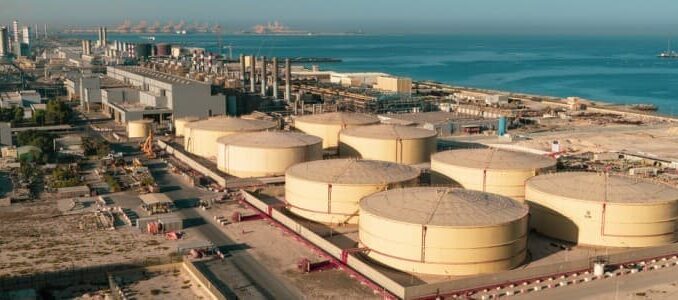
Slowing global oil demand growth next year, spiking food prices, and fears of recession in major oil-importing countries are set to slow economic growth in the Middle East, whose major oil producers are enjoying this year a windfall of oil revenues and the highest growth in years. Economies in the Arab Gulf states that are part of the Gulf Cooperation Council (GCC)—Bahrain, Kuwait, Oman, Qatar, Saudi Arabia, and the United Arab Emirates (UAE)—are on track for the fastest economic growth in years and for budget surpluses, for some of them the first surpluses in a decade.
Growth in the GCC is expected at 6.2% this year, according to a Reuters poll of economists who revised up their 5.9% economic growth forecast from a similar poll in April.
However, growth will slow down next year, to 3.8% across the GCC, the economists reckon.
“A broadening or worsening of the war in Ukraine could tip the global economy into recession, pushing oil prices down sharply even if oil supply remains constrained, hitting regional growth and fiscal balances,” Ensaf Al-Matrouk, assistant economist at NBK, told Reuters.
$100 Oil Is A Boon To Middle East’s Oil Exporters
Triple-digit oil prices have accelerated economic growth in the major Middle Eastern oil exporters, including the world’s largest crude oil exporter, Saudi Arabia. Oil revenues are soaring, fiscal balances are strong, and growth – fueled by higher oil prices and higher oil production as OPEC+ rolls back the output cuts – is being revised up. Moreover, inflation is not as high in Middle Eastern oil exporters as it is in the United States and Europe, which protects the Gulf economies to some extent from global inflationary pressures.
The Saudi economy, for example, is set for stronger performance this year than previously expected amid high oil prices, the International Monetary Fund (IMF) said in April, revising its growth forecast to 7.6% for 2022, up by 2.8 percentage points from the previous estimate.
For the first quarter alone, Saudi Arabia’s economy grew by 9.9% annually, the highest growth rate since 2011, the General Authority for Statistics says, attributing the growth to the “high increase in oil activities,” which surged by 20.3% year over year. Moreover, Saudi Arabia booked a budget surplus of $15.3 billion (57.491 billion Saudi riyals) in the first quarter, the ministry of finance said in May. Oil revenues soared by 58 percent to $49 billion (183.7 billion Saudi riyals) between January and March, when oil prices surged to above $100 a barrel, the finance ministry data showed.
For the whole of 2022, the Saudi economy is set to grow by 7.6%, the fastest growth pace in more than a decade, according to the Reuters poll. This is in line with the IMF projection from April.
Slowdown in 2023
Next year, however, the pace of growth in Saudi Arabia and the GCC is set to halve, with 3.8% growth expected for the GCC countries and 3.3% for Saudi Arabia by the Reuters poll. The IMF also predicts slower growth in Saudi Arabia next year, at 3.6%.
If recession fears in Europe or the U.S. materialize, economic growth in the Middle East could be even slower as a recession would curb global oil demand growth or could even lead to a decline in consumption year over year. The Gulf economies, dependent on oil revenues, would feel the sting of potentially lower demand and lower oil prices once again.
That’s why the IMF and other major economic forecasters and bodies have been advising Saudi Arabia and all of the Middle Eastern oil and gas exporters for years to speed up the diversification of economies and not to rely on the cyclical nature of the oil windfall.
“Fiscal policy should focus on managing the higher oil revenue gains sustainably,” the IMF said last month about the Saudi economy.
Much lower inflation in Saudi Arabia and other major oil exporters than the largest jump in consumer prices in 40 years in the U.S. and many countries in Europe is a good thing for the Middle East economies now, analysts say.
In Saudi Arabia, headline inflation is set to accelerate in the second half of 2022, but will remain contained at 2.8 percent on average in 2022 as an appreciating U.S. dollar to which the Saudi riyal is pegged, caps on gasoline prices, and subsidies on wheat help contain pressure from supply-side shocks, the IMF said in June.
Despite slower expected growth next year, the sovereign outlook on the Middle East remains at “improving,” per Fitch Ratings’ latest outlook. The rating agency revised the global sovereign credit conditions to “neutral” from “improving,” due to the impact of the Russian invasion of Ukraine and consequent sanctions on geopolitical risk, trade and capital flows, and economic growth and inflation.
“The Middle East and North Africa (MENA) is the only region to maintain its improving sector outlook assigned at end-2021. Oil-exporting sovereigns will register significantly stronger public finances and growth in 2022, although the economic picture will be much more challenging outside the Gulf Cooperation Council,” Fitch Ratings said at the end of last month.
Source: Oilprice.com



